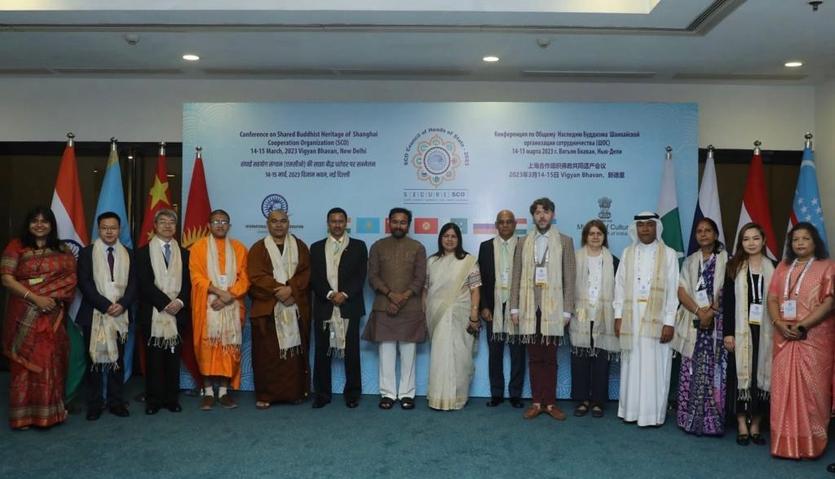 Participants in the SCO conference on "Shared Buddhist Heritage" in New Delhi include India’s federal Minister of Culture G. Kishan Reddy and Junior federal minister of external affairs Meenakshi Lekhi. (PHOTO PROVIDED TO CHINA DAILY)
Participants in the SCO conference on "Shared Buddhist Heritage" in New Delhi include India’s federal Minister of Culture G. Kishan Reddy and Junior federal minister of external affairs Meenakshi Lekhi. (PHOTO PROVIDED TO CHINA DAILY)
China’s archeological conservation and restoration efforts drew high praise at an international conference of the Shanghai Cooperation Organization held recently in New Delhi on “Shared Buddhist Heritage”.
The event, which took place from March 14 to15 and focused on India’s civilization connection with the SCO nations, was organized by India’s federal ministry of Culture and the International Buddhist Confederation, or IBC.
China’s efforts to restore Buddhist sites are commendable, said K Warikoo, a professor and founder of the Central Asian Studies Programme at the Jawaharlal Nehru University, New Delhi
It was held with an aim “to re-establish trans-cultural links, seek out commonalities between Buddhist art of Central Asia, art styles, archeological sites, and antiquity in various museums’ collections of the SCO countries,” according to an IBC press statement.
READ MORE: Smartphones meet sutras at ancient monastery
The experience of the Dunhuang Cultural Complex in China shows that the murals and the artefacts have been restored well, and this should be taken as a model to develop Buddhist sites in India, Tajikistan, Uzbekistan and Kyrgyzstan, experts said, also mentioning restoration efforts at Buddhist sites in China’s Yunnan province.
China’s efforts to restore Buddhist sites are commendable, said K Warikoo, a professor and founder of the Central Asian Studies Programme at the Jawaharlal Nehru University, New Delhi.
Speaking to China Daily over the phone, Warikoo said India must follow the example of China and do more to protest the Buddhist heritage, including collaboration with the Dunhuang Cultural Complex.
The two nations should organize photo exhibitions, books fair, video films and documentary film exhibitions to showcase their rich Buddhist heritage to each other and their efforts to maintain the places, Warikoo said.
Lord Buddha had shown the middle path that is very relevant in these fraught times for the world. This needs to be preserved in the right spirit, a speaker said at the New Delhi conference.
Shengliang Zhao, a researcher from China's Dunhuang Research Academy, said the event offered a huge opportunity for India and China to celebrate history.
"This conference gives a huge message of India and China coming together in all aspects culturally ... peacefully. We will be moving ahead with this peaceful heritage further," Zhao said in his remarks that were later translated.
Speaking about the Dunhuang Mogao Grottoes, (the thousand Buddha caves), Zhao showed many slides at the conference that highlighted the influence of Indian caitya, or stupa, on the caves and their artwork in the region. Providing examples, he said the central pillar in Cave 482 of Mogao was influenced by Ajanta's Cave No 10 in India.
Similarly, one can notice some commonalities between Buddhist sculptures in India’s Madhura and China’s Binglingsi caves. There were references to other cross-border influences. Ajanta cave-painting techniques, for instance, influenced the paintings of murals in the Dunhuang complex.
Zhao noted that Buddhism came from India, but developed in China for a long time. Due to the prosperity and development of the Silk Road, the continuous exchange of Eastern and Western cultures has left an extremely rich heritage in Dunhuang.
Indian tourism and culture minister, G.K. Reddy, said that the conference highlighted Buddhist common heritage among nations signifying civilizational connections, a good basis to build stronger and deeper bonds amongst the SCO countries.
“Today, we have all gathered here, at a first of its kind conference, because of this underlying link that binds us. The purpose of this conference is to renew trans-cultural links and shared histories between the nations gathered here,” the minister said.
Arjun Ram Meghwal, India’s junior minister of state for parliamentary affairs and culture, suggested at the conference that the SCO countries should take up programs and projects on the shared Buddhist heritage which binds them together.
Buddhism finds a place in global culture because of its universal and value-based teachings, Meghwal said.
“Buddhism is like a banyan tree; its roots firmly in India while the branches spread to Central Asia, China, Far East and in the Indian Sub-continent,” Anupa Pande, pro-vice-Chancellor of the National Museum Institute of History of Art, Conservation and Museology in New Delhi, said, summing up the sentiments expressed by all participants, according to the IBC statement.
There is an urgent need to preserve and restore the remnants of the rich Buddhist heritage currently in ruins in parts of Central Asia, the statement said.
China is at the top in preserving Buddhist heritage, and Chinese archaeologists have been meticulously working on the archaeological discoveries, and their work is highly praiseworthy, Shashi Bala, dean of Bhavan’s KM Munshi Centre for Indology, New Delhi, told China Daily.
READ MORE: World Buddhist Forum to discuss religion's contemporary value
Buddhist philosophical texts are difficult to understand and the way ancient Chinese scholars had given them a pictorial form is unique, Bala said, adding that Chinese archaeologists have also done wonderful work to preserve Buddhist sites.
Bala, who was a moderator at the March 14-15 New Delhi conference, said the Chinese government is keen to see Buddhist archaeological sites well-restored and well-preserved.
“The Conference is a unique meeting of the minds, where countries from different geographical regions but with a common thread connecting them based on a shared civilization legacy, strengthened by Buddhist missionaries, …. chalking out ways to continue the age-old bonds into the future,” said a statement issued by the federal ministry of culture.
The writer is a freelance journalist for China Daily.


